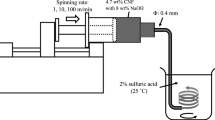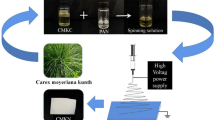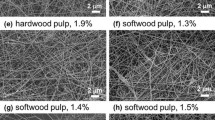Abstract
Toilet paper was used to produce cellulosic nanofibers through electrospinning method. Dissolution of toilet paper was attempted in either solutions of 0.5–8.5 wt% lithium chloride in Dimethylacetamide (LiCl/DMAc) or Trifluoroacetic acid (TFA). LiCl/DMAc solvent with concentrations lower than 8 wt% was incapable of completely dissolving the toilet paper even though several days of interaction. 8 wt% solvent dissolved the toilet paper, but the obtained solution was too viscous for spinning, and spraying occurred rather than spinning, and hardly visible deposits with fringed structure formed. In contrast, TFA solution dissolved the toilet paper, and the solutions could be spun easily. In these tests, spinning parameters were changed within the feeding rates of 2.00–9.25 mL/h, needle tip-to-collection plate distances of 140–205 mm, voltage of 23–28 kV, and relative humidity of 53–70%. The produced fibers were characterized by Scanning Electron Microscopy (SEM), X-ray Diffraction (XRD), and Fourier-Transform Infrared Spectroscopy (FTIR). It was concluded that the produced fibers are ultrafine with nanoscale diameter, and the morphologies of produced fibers are severely in the shape of bead-on-string fibers. Besides, the use of TFA solvent led to reduction in the crystallinity of cellulose that is one of the typical intrinsic characteristics of cellulose.







Similar content being viewed by others
Abbreviations
- CA:
-
Cellulose acetate
- CrI:
-
Crystallinity index
- DMAc:
-
Dimethylacetamide
- FTIR:
-
Fourier-Transform Infrared Spectroscopy
- ILc:
-
Ionic liquids
- Imax :
-
Intensity maximum between 2θ = 22° and 23°
- Imin :
-
Intensity minimum between 2θ = 18° and 19°
- LiCl:
-
Lithium chloride
- SEM:
-
Scanning Electron Microscopy
- TFA:
-
Trifluoroacetic acid
- XRD:
-
X-ray Diffraction
References
Santos RPO, Rodrigues BVM, Ramires EC, Ruvolo-Filho AC, Frollini EC (2015) Bio-based materials from the electrospinning of lignocellulosic sisal fibers and recycled PET. Ind Crops Prod 72:69–76. https://doi.org/10.1016/j.indcrop.2015.01.024
Rodrigues BVM, Ramires EC, Santos RPO, Frollini E (2014) Ultrathin and nanofibers via room temperature electrospinning from trifluoroacetic acid solutions of untreated lignocellulosic sisal fiber or sisal pulp. J Appl Polym Sci 41826:1–8. https://doi.org/10.1002/APP.41826
Bhardwaj N, Kundu S (2010) Electrospinning: a fascinating fiber fabrication technique. Biotechnol Adv 28:325–347. https://doi.org/10.1016/j.biotechadv.2010.01.004
Viswanathan G, Murugesan S, Pushparaj V, Nalamasu O, Ajayan PM, Linhardt RJ (2006) Preparation of biopolymer fibers by electrospinning from room temperature ionic liquids. Biomacromol 7:415–418. https://doi.org/10.1021/bm050837s.
Ahn Y, Lee SH, Kim HJ, Yang YH, Hong JH, Kim YH, Kim H (2012) Electrospinning of lignocellulosic biomass using ionic liquid. Carbohydr Polym 88:395–398. https://doi.org/10.1016/j.carbpol.2011.12.016
Chen H, Ni J, Chen J, Xue W, Wang J, Na H, Zhu J (2015) Activation of corn cellulose with alcohols to improve its dissolvability in fabricating ultrafine fibers via electrospinning. Carbohydr Polym 123:174–179. https://doi.org/10.1016/j.carbpol.2015.01.023
Mahadeva SK, Yang SY, Kim J (2013) Effects of solvent systems on its structure, properties and electromechanical behavior of cellulose electro-active paper. Curr Org Chem 17:83–88. https://doi.org/10.2174/138527213805289114
Schiffman JD, Schauer CL (2008) A review: electrospinning of biopolymer nanofibers and their applications. Polym Rev 48:317–352. https://doi.org/10.1080/15583720802022182
Awal A, Sain M, Chowdhury M (2011) Preparation of cellulose-based nano-composite fibers by electrospinning and understanding the effect of processing parameters. Compos B 42:1220–1225. https://doi.org/10.1016/j.compositesb.2011.02.011
Greiner A, Wendorff JH (2007) Electrospinning: a fascinating method for the preparation of ultrathin fibers. Angew Chem Int Ed 46:5670–5703. https://doi.org/10.1002/anie.200604646
Hardelin L, Thunberg J, Perzon E, Westman G, Walkenström P, Gatenholm P (2012) Electrospinning of cellulose nanofibers from ionic liquids: the effect of different cosolvents. J Appl Polym Sci 125:1901–1909. https://doi.org/10.1002/app.36323
Ohkawa K, Hayashi S, Nishida A, Yamamoto H (2009) Preparation of pure cellulose nanofiber via electrospinning. Text Res J 79:1396–1401. https://doi.org/10.1177/0040517508101455
Naqvi SR, Mysore Prabhakara H, Bramer EA, Dierkes W, Akkreman R, Brem G (2018) A critical review on recycling of end-of-life carbon fibre/glass fibre reinforced composites waste using pyrolysis towards a circular economy. Resour Conserv Recy 136:118–129. https://doi.org/10.1016/j.resconrec.2018.04.013
Na O, Xi YP (2017) Mechanical and durability properties of insulation mortar with rubber powder from waste tires. J Mater Cycles Waste Manage 19:763–773. https://doi.org/10.1007/s10163-016-0475-2
Chand S (2000) Review-Carbon fibers for composites. J Mater Sci 35:1303–1313. https://doi.org/10.1023/A:1004780301489
Deitzel JM, Kleinmeyer J, Harris D, Tan NCB (2001) The effect of processing variables on the morphology of electrospun nanofibers and textiles. Polymers 42:261–272. https://doi.org/10.1016/S0032-3861(00)00250-0
Frey MW (2008) Electrospinning cellulose and cellulose derivatives. Polym Rev 48:378–391. https://doi.org/10.1080/15583720802022281
Kim CW, Frey MW, Marquez M, Joo YL (2005) Preparation of submicron-scale, electrospun cellulose fibers via direct dissolution. J Polym Sci Part B Polym Phys 43:1673–1683. https://doi.org/10.1002/polb.20475
Wang M, Hai T, Feng Z, Yu DG, Yang Y, Bligh SWA (2019) The Relationships between the working fluids, process characteristics and products from the modified coaxial electrospinning of Zein. Polymers 11:1287. https://doi.org/10.3390/polym11081287
Sukigara S, Gandhi M, Ayutsede J, Micklus M, Ko F (2003) Regeneration of Bombyx mori silk by electrospinning—part 1: processing parameters and geometric properties. Polym 44:5721–5727. https://doi.org/10.1016/S0032-3861(03)00532-9
Son WK, Youk JH, Park WH (2004) Preparation of ultrafine oxidized cellulose mats via electrospinning. Biomacromol 5:197–201. https://doi.org/10.1021/bm034312g
Zhang L, Li L, Wang L, Nie J, Ma G (2020) Multilayer electrospun nanofibrous membranes with antibacterial property for air filtration. Appl Surf Sci 515:145962. https://doi.org/10.1016/j.apsusc.2020.145962
Rethinam S, Basaran B, Vijayan S, Mert A, Bayraktar O, Aruni AW (2020) Electrospun nano-bio membrane for bone tissue engineering application- a new approach. Mater Chem Phys 249:123010. https://doi.org/10.1016/j.matchemphys.2020.123010
Zhu Y, Wu Y, Wang G, Wang Z, Tan Q, Zhao L, Wu D (2020) A flexible capacitive pressure sensor based on an electrospun polyimide nanofiber membrane. Org Electron 84:105759. https://doi.org/10.1016/j.orgel.2020.1
Shekh MI, Amirian J, Stadler FJ, Du B, Zhu Y (2020) Oxidized chitosan modified electrospun scaffolds for controllable release of acyclovir. Int J Bio Macromol 151:787–796. https://doi.org/10.1016/j.ijbiomac.2020.02.230
Wsoo MA, Shahir S, Bohari SPM, Nayan NHM, Razak SIA (2020) A review on the properties of electrospun cellulose acetate and its application in drug delivery systems: a new perspective. Carbohydr Res 491:107978. https://doi.org/10.1016/j.carres.2020.107978
Bhadra J, Parangusan H, Popelka A, Lehocky M, Humpolicek P, Al-Thania N (2020) Electrospun polystyrene/PANI-Ag fibers for organic dye removal and antibacterial application. J Environ Chem Eng 8:103746. https://doi.org/10.1016/j.jece.2020.103746
Zhang X, Huang Y, Zhou X, Wang F, Luo Z, Wu Q (2020) Characterizations of carbonized electrospun mats as diffusion layers for direct methanol fuel cells. J Power Sources 448:227410. https://doi.org/10.1016/j.jpowsour.2019.227410
Yin X, Zhang Z, Ma H, Venkateswaran S, Hsiao BS (2020) Ultra-fine electrospun nanofibrous membranes for multicomponent wastewater treatment: Filtration and adsorption. Sep Purif Technol 242:116794. https://doi.org/10.1016/j.seppur.2020.116794
Mukhiya T, Dahal B, Ojha GP, Chhetri K, Lee M, Kim T, Chae SH, Tiwari AP, Muthurasu A, Kim HY (2019) Silver nanoparticles entrapped cobalt oxide nanohairs/electrospun carbon nanofibers nanocomposite in apt architecture for high performance supercapacitors. Compos B 178:107482. https://doi.org/10.1016/j.compositesb.2019.10
Leyva BM, Felix FR, Chavez PT, Wong BR, Cervantes JL, Machado DS (2011) Preparation and characterization of durum wheat (triticum durum) straw cellulose nanofibers by electrospinning. J Agric Food Chem 59:870–875. https://doi.org/10.1021/jf103364a
Reddy N, Yang Y (2006) Properties of high-quality long natural cellulose fibers from rice straw. J Agric Food Chem 54:8081–8977. https://doi.org/10.1021/jf0617723
Costa SM, Mazzola PG, Silva JCAR, Pahl R, Pessoa A Jr, Costa SA (2013) Use of sugar cane straw as a source of cellulose for textile fiber production. Ind Crops Prod 42:189–194. https://doi.org/10.1016/j.indcrop.2012.05.028
Maheswari CU, Reddy KO, Muzenda E, Guduri BR, Rajulu AV (2012) Extraction and characterization of cellulose microfibrils from agricultural residue—Cocos nucifera L. Biomass Bioenerg 46:555–563. https://doi.org/10.1016/j.biombioe.2012.06.039
Li C, Chen R, Zhang X, Xiong J, Zheng Y, Dong W (2011) Fabrication and characterization of electrospun nanofibers of high DP natural cotton lines cellulose. Fibers Polym 12(3):345–351. https://doi.org/10.1007/s12221-011-0345-4
Haule LV, Carr CM, Rigout M (2016) Preparation and physical properties of regenerated cellulose fibres from cotton waste garments. J Cleaner Prod 112:4445–4451. https://doi.org/10.1016/j.jclepro.2015.08.086
Sjöholm E, Gustafsson K, Eriksson B, Brown W, Colmsjö A (2000) Aggregation of cellulose in lithium chloride/N, N-dimethylacetamide. Carbohydr Polym 41:153–161. https://doi.org/10.1016/S0144-8617(99)00080-6
Dupont AL (2003) Cellulose in lithium chloride/N;N-dimethylacetamide, optimisation of a dissolution method using paper substrates and stability of the solutions. Polym 44:4117–4126. https://doi.org/10.1016/S0032-3861(03)00398-7
Hamad AA, Hassouna MS, Shalaby TI, Elkady MF, Abd Elkawi MA, Hamad HA (2020) Electrospun cellulose acetate nanofiber incorporated with hydroxyapatite for removal of heavy metals. Int J Biol Macromol 151:1299–1313. https://doi.org/10.1016/j.ijbiomac.2019.10.176
Ojstrsek A, Fakin D, Hribernik S, Fakin T, Bracic M, Kurecic M (2020) Electrospun nanofibrous composites from cellulose acetate/ultra-high silica zeolites and their potential for VOC adsorption from air. Carbohydr Polym 236:116071. https://doi.org/10.1016/j.carbpol.2020.116071
Chen Y, Qiu LL, Ma XY, Dong LK, Jin ZF, Xia GB et al (2020) Electrospun cellulose polymer nanofiber membrane with flame resistance properties for lithium-ion batteries. Carbohydr Polym 234:115907. https://doi.org/10.1016/j.carbpol.2020.115907
Tanvir A, Ting VP, Eichhorn SJ (2020) Nanoporous electrospun cellulose acetate butyrate nanofibers for oil sorption. Mater Lett 261:127116. https://doi.org/10.1016/j.matlet.2019.127116
Zhu MN, Cao QP, Liu BY, Guo HY, Wang X, Han Y et al (2020) A novel cellulose acetate/poly (ionic liquid) composite air filter. Cellulose 27:3889–3902. https://doi.org/10.1007/s10570-020-03034-8
de Almeida DS, Duarte EH, Hashimoto EM, Turbiani FRB, Muniz EC, de Souza PR et al (2020) Development and characterization of electrospun cellulose acetate nanofibers modified by cationic surfactant. Polym Test 81:106206. https://doi.org/10.1016/j.polymertesting.2019.106206
Araga R, Sharma CS (2019) Amine functionalized electrospun cellulose nanofibers for fluoride adsorption from drinking water. J Polym Environ 27:816–826. https://doi.org/10.1007/s10924-019-01394-2
Bacarin GB, Dognani G, dos Santos RJ, Meirelles MG, Rodrigues TF, Klauck CR et al (2020) Natural rubber composites with Grits waste from cellulose industry. J Mater Cycles Waste Manage. https://doi.org/10.1007/s10163-020-01011-8(Early Access- March 2020)
Ishii D, Tatsumi D, Matsumoto T (2008) Effect of solvent exchange on the supramolecular structure, the molecular mobility and the dissolution behavior of cellulose in LiCl/DMAc. Carbohydr Res 343:919–928. https://doi.org/10.1016/j.carres.2008.01.035
van de Ven T, Godbout L (2013) Cellulose fundamental aspects. Intech Open, Croatia (ISBN: 978-953-51-1183-2)
Li B, Ding L, Xu HF, Mu XD, Wang HS (2017) Multivariate data analysis applied in alkali-based pretreatment of corn stover. Resour Conserv Recycl 122:307–318. https://doi.org/10.1016/j.resconrec.2016.12.007
De Souza AG, Rocha DB, Kano FS, dos Santos RD (2019) Valorization of industrial paper waste by isolating cellulose nanostructures with different pretreatment methods. Resour Conserv Recycl 143:133–142. https://doi.org/10.1016/j.resconrec.2018.12.031
Chen WF, Zhang SJ, He FF, Lu WP, Xv H (2019) Porosity and surface chemistry development and thermal degradation of textile waste jute during recycling as activated carbon. J Mater Cycles Waste Manage 21:315–325. https://doi.org/10.1007/s10163-018-0792-8
Nowrouzi M, Behin J, Younesi H, Bahramifar N, Charpentier PA, Rohani S (2017) An enhanced counter-current approach towards activated carbon from waste tissue with zero liquid discharge. Chem Eng J 326:934–944. https://doi.org/10.1016/j.cej.2017.05.141
Yousef S, Hamdy M, Tatariants M, Tuckute S, El-Abden SZ, Kliucininkas L, Baltusnikas A (2019) Sustainable industrial technology for recovery of cellulose from production waste and reprocessing into cellulose nanocrystals. Resour Conserv Recycl 149:510–520. https://doi.org/10.1016/j.resconrec.2019.06.026
Chen R, Nie Y, Kato H, Wu J, Utashiro T, Lu J, Yue S, Jiang H, Zhang L, Li YY (2017) Methanogenic degradation of toilet-paper cellulose upon sewage treatment in an anaerobic membrane bioreactor at room temperature. Bioresour Technol 228:69–76. https://doi.org/10.1016/j.biortech.2016.12.089
Son WK, Youk JH, Lee TS, Park WH (2004) Electrospinning of ultrafine cellulose acetate fibers: studies of a new solvent system and deacetylation of ultrafine cellulose acetate fibers. J Polym Sci Part B Polym Phys 42:5–11. https://doi.org/10.1002/polb.10668
Kamide K (2005) Cellulose and cellulose derivatives—molecular characterization and its applications. Elsevier, New York (ISBN: 978-0-444-82254-3)
Barhoum A, Makhlouf ASH (2018) Fundamentals of nanoparticles—classifications, synthesis methods, properties and characterization. Elsevier, Amsterdam (ISBN: 978-0-323-51255-8)
Ramakrishna S, Fujihara K, Teo WE, Lim TC, Ma Z (2005) An introduction to electrospinning and nanofibers. World Scientific Publishing Co, Singapore (ISBN 981-256-425-2)
Rosenau T, Potthast A, Hell J (2018) Cellulose science and technology-chemistry, analysis, and applications. Wiley, New Jersey
Sukudom N, Jariyasakoolroj P, Jarupan L, Tansin K (2019) Mechanical, thermal, and biodegradation behaviors of poly(vinyl alcohol) biocomposite with reinforcement of oil palm frond fiber. J Mater Cycles Waste Manage 21:125–133. https://doi.org/10.1007/s10163-018-0773-y
He X, Cheng L, Zhang X, Xiao Q, Zhang W, Lu C (2015) Tissue engineering scaffolds electrospun from cotton cellulose. Carbohydr Polym 115:485–493. https://doi.org/10.1016/j.carbpol.2014.08.114
Ciolacu D, Ciolacu F, Popa V (2011) Amorphous cellulose—structure and characterization. Cellul Chem Technol 45:13–21
Kargarzadeh H, Sheltami RM, Ahmad I, Abdullah I, Dufresne A (2015) Cellulose nanocrystal: a promising toughening agent for unsaturated polyester nanocomposite. Polym 56:346–357. https://doi.org/10.1016/j.polymer.2014.11.054
Park YB, Lee CM, Koo BW, Park S, Cosgrove DJ, Kim SH (2013) Monitoring meso-scale ordering of cellulose in intact plant cell walls using sum frequency generation spectroscopy. Plant Physiol 163:907–913. https://doi.org/10.1104/pp.113.225235
Regiani AM, Frollini E, Marson GA, Arantes GM, El Seoud OA (1999) Some aspects of acylation of cellulose under homogeneous solution conditions. J Polym Sci Part A Polym Chem 37:1357–1363
Zhao YY, Yang QB, Lu XF, Wang C, Wei Y (2005) Study on correlation of morphology of electrospun products of polyacrylamide with ultrahigh molecular weight. J Polym Sci 43:2190–2195. https://doi.org/10.1002/polb.20506
Lee KH, Kim HY, Bang HJ, Jung YH, Lee SG (2003) The change of bead morphology formed on electrospun polystyrene fibers. Polymers 44:4029–4034. https://doi.org/10.1016/S0032-3861(03)00345-8
Fong H, Chun I, Reneker DH (1999) Beaded nanofibers formed during electrospinning. Polymers 40:4585–4592. https://doi.org/10.1016/S0032-3861(99)00068-3
Zhao H, Chi H (2018) Electrospun bead-on-string fibers: useless or something of value? In: Lin T (ed) Novel aspects of nanofibers. Intechopen limited, London, p 87
Langer R (2000) Biomaterials in drug delivery and tissue engineering: one laboratory’s experience. Acc Chem Res 33:94–101. https://doi.org/10.1021/ar9800993
Kaur S, Sundarrajan S, Rana D, Matsuura T, Ramakrishna S (2012) Influence of electrospun fiber size on the separation efficiency of thin film nanofiltration composite membrane. J Membr Sci 392:101–111. https://doi.org/10.1016/j.memsci.2011.12.005
Yun K, Hogan C, Matsubayashi Y, Kawabe M, Iskandar F, Okuyama K (2007) Nanoparticle filtration by electrospun polymer fibers. Chem Eng Sci 62:4751–4759. https://doi.org/10.1016/j.ces.2007.06.007
Xue MQ, Li FW, Wang Y, Cai XJ, Pan F, Chen JT (2013) Ultralow-limit gas detection in nano-dumbbell polymer sensor via electrospinning. Nanoscale 5:1803–1805. https://doi.org/10.1039/c3nr34090b
Acknowledgement
This work was financially supported by the Scientific Research Projects (BAP) Unit of Istanbul Technical University (Project number: MYL-2018-41504). Also, the authors would like to thank Aysen Akturk (MSc) for her helps.
Author information
Authors and Affiliations
Corresponding author
Additional information
Publisher's Note
Springer Nature remains neutral with regard to jurisdictional claims in published maps and institutional affiliations.
Rights and permissions
About this article
Cite this article
Kiper, A.G., Özyuguran, A. & Yaman, S. Electrospun cellulose nanofibers from toilet paper. J Mater Cycles Waste Manag 22, 1999–2011 (2020). https://doi.org/10.1007/s10163-020-01085-4
Received:
Accepted:
Published:
Issue Date:
DOI: https://doi.org/10.1007/s10163-020-01085-4




